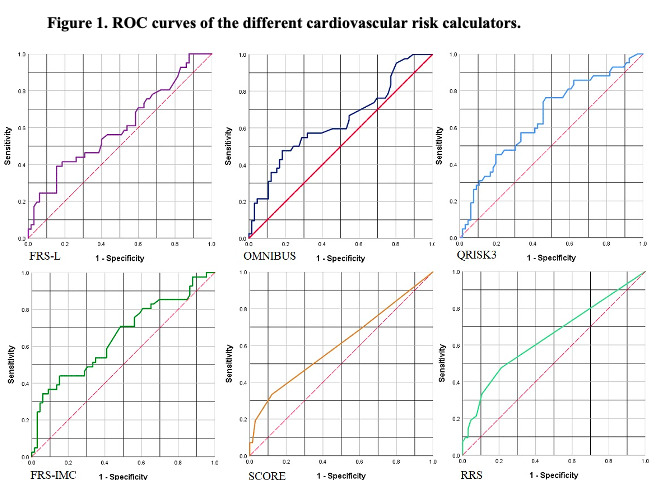Session Information
Date: Saturday, November 6, 2021
Title: RA – Diagnosis, Manifestations, & Outcomes Poster I: Cardiovascular Pulmonary Disease (0268–0295)
Session Type: Poster Session A
Session Time: 8:30AM-10:30AM
Background/Purpose: A relationship between rheumatoid arthritis (RA) and the presence of abnormalities in left ventricular (LV) geometry such as eccentric remodeling has recently been determined, even in the absence of cardiovascular risk factors and before clinical manifestations. The 2016 EULAR recommendations that cardiovascular (CV) risk prediction models should be adapted by a 1.5 multiplication factor in RA patients. Risk prediction algorithms based on the CV risk factors have been an important tool for adopting preventive measures and intensifying therapies based on the estimated risk but their application in predicting cardiac structural abnormalities has never been studied. The aim of the study is to determine the CV risk calculator that best predicts alterations in ventricular geometry in RA.
Methods: A cross-sectional, observational study of 108 RA patients between 40-75 years, who fulfilled ACR/EULAR 2010 classification criteria. The QRISK3, OMNIBUS, Framingham Risk Score-Lipids, Framingham Risk Score-Body Mass Index (FRS-BMI) and Reynolds Risk Score (RRS) calculators were compared. The diagnostic performance was determined by ROC curves, and the discriminative capacity by the Area Under the Curve (AUC) 95% CI. The echocardiogram was the diagnostic gold standard.
Results: The prevalence of abnormalities in LV geometry was 38.9%. QRISK3 reported AUC of 0.656, 95% CI (0.537-0.754, p = 0.012), cut-off point ≥4.6, sensitivity of 73.8% and specificity of 54.5%, and likelihood ratio of +1.62. FRS-BMI showed AUC of 0.642, 95% CI (0.543-0.762, p = 0.008), cut-off point ≥11.02, sensitivity and specificity of 61.9% and 57.6% respectively, and likelihood ratio of +1.46. OMNIBUS showed AUC of 0.635, CI 95% (0.525-0.746, p = 0.018), cut-off point ≥3.8, sensitivity and specificity of 57.1% and 68.2%. While RRS had AUC 0.644, 95% CI (0.534-0.755, p = 0.012), cut-off point of 2.25, sensitivity of 47.6% and specificity 78.8%, and likelihood ratio of +2.24 (Figure 1 and Table 1).
Conclusion: The QRISK3 calculator showed the highest discriminative ability and sensitivity to predict abnormalities in LV geometry. However, all calculators demonstrated the need for a lower cut-off point to predict alterations in ventricular geometry. Our findings require adequate reproducibility in other population groups to determine the applicability of CV risk algorithms as predictors of structural alteration of LV.
To cite this abstract in AMA style:
Rodriguez-Romero A, Azpiri-Lopez J, Galarza-Delgado D, Colunga-Pedraza I, Davila-Jimenez J, Guajardo-Jauregui N, Meza-Garza A, Loya-Acosta J, Cardenas-de La Garza J, Lugo-Perez S, De Leon-Yañez A, Andrade-Vazquez C. Best Cardiovascular Risk Algorithm to Predict Abnormalities in Left Ventricular Geometry in Rheumatoid Arthritis Patients [abstract]. Arthritis Rheumatol. 2021; 73 (suppl 9). https://acrabstracts.org/abstract/best-cardiovascular-risk-algorithm-to-predict-abnormalities-in-left-ventricular-geometry-in-rheumatoid-arthritis-patients/. Accessed .« Back to ACR Convergence 2021
ACR Meeting Abstracts - https://acrabstracts.org/abstract/best-cardiovascular-risk-algorithm-to-predict-abnormalities-in-left-ventricular-geometry-in-rheumatoid-arthritis-patients/


